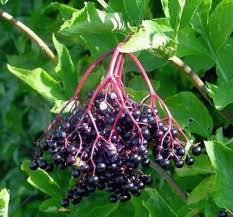Elder locally has many different names. Bush and berries are quite well known. But regularly someone heard sometimes elder is toxic. Is that right?
The branches have a soft marrow, so the wood can be used for whistles and blowpipes. Twigs and leaves repel moles and aphids. Of blossom we can make lemonade, wine, tea and fritters. The ripe berries deliver us sweets and (cough) syrup, jams, fruit juice, wine and elderberry gin.
The berries are slightly toxic by sambunigrin, which rendered harmless by boiling. But the berries of the elderberry herb are toxic. So still be a little careful.
The common species here
 The (black)elder(berry) (Sambucus nigra) with black berries is the most common. The leaves are dark green and are cross-wise with each other. The top consists of 5-7 short-stemmed leaves that have a sharply serrated edge. The pith is white. (A naturally occurring variety of the common elder, the Cut-Leaved Elder (Sambucus nigra var. Laciniata), has deeply cut leaves.)
The (black)elder(berry) (Sambucus nigra) with black berries is the most common. The leaves are dark green and are cross-wise with each other. The top consists of 5-7 short-stemmed leaves that have a sharply serrated edge. The pith is white. (A naturally occurring variety of the common elder, the Cut-Leaved Elder (Sambucus nigra var. Laciniata), has deeply cut leaves.)
The red elderberry (Sambucus racemosa) grows in the colder parts of the northern hemisphere (here in South Limburg and Achterhoek) and has not black but bright red berries. The inflorescences contain 3 to 6 seeds. He is smaller than the common elder. The inflorescences with in April-May yellow-white flowers are rather bunches than screens. The leaves are narrow with a pointed top. The edges are roughly serrated. The berries have a laxative effect. The raw seeds in the berries are poisonous. The pith colors cinnamon.
The dwarf elderberry (Sambucus ebulus) is a rare species that is found on calcareous soils in arable and forest edges. It is a perennial that dies in the autumn and regrows in spring weather. The stems therefore never become woody branches. This shrub is at most one and a half meters. The leaves have seven to eleven parts, and the shrub blooms a bit later (July and August) than regular Black Elderberry. All parts are (more)poisonous (then elder).
Scientists have identified a chemical compound in elderberries that immediately immobilizes the flu virus.
Elderberry extract can relieve flu symptoms and shorten the duration of the disease.
With preventive intake during the flu season, the phytochemicals in elderberries would prevent the virus from entering or attaching to our healthy cells and causing the virus to multiply. Proteins that ensure viral attachment and access to host cells would be blocked. Already infected cells would be stimulated to coordinate a more efficient response.
